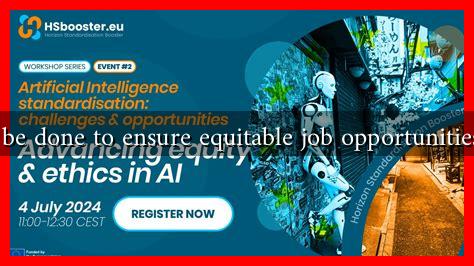-
Table of Contents
- What Can Be Done to Ensure Equitable Job Opportunities with AI?
- Understanding the Challenges of AI in Employment
- Strategies for Promoting Equitable Job Opportunities
- 1. Implementing Inclusive AI Policies
- 2. Investing in Education and Training
- 3. Fostering Collaboration Between Stakeholders
- Case Studies and Examples
- Conclusion
What Can Be Done to Ensure Equitable Job Opportunities with AI?
As artificial intelligence (AI) continues to reshape the job market, the potential for both positive and negative impacts on employment is significant. While AI can enhance productivity and create new job categories, it also poses risks of job displacement and inequality. To ensure equitable job opportunities in an AI-driven world, a multifaceted approach is necessary. This article explores strategies that can be implemented to promote fairness and inclusivity in the evolving job landscape.
Understanding the Challenges of AI in Employment
AI technologies are increasingly being integrated into various sectors, leading to both opportunities and challenges. Some of the key issues include:
- Job Displacement: Automation can lead to the elimination of certain jobs, particularly in manufacturing and routine tasks.
- Bias in AI Algorithms: AI systems can perpetuate existing biases if they are trained on biased data, leading to unfair hiring practices.
- Skill Gaps: The rapid advancement of AI technologies can create a mismatch between the skills workers possess and those required by employers.
Strategies for Promoting Equitable Job Opportunities
To address these challenges, several strategies can be implemented by governments, organizations, and educational institutions:
1. Implementing Inclusive AI Policies
Governments and organizations should develop policies that promote inclusivity in AI deployment. This includes:
- Regulating AI Development: Establishing guidelines to ensure that AI systems are designed and tested for fairness.
- Encouraging Diversity in Tech: Promoting diversity in AI development teams to reduce bias in algorithms.
- Transparency in AI Processes: Ensuring that AI decision-making processes are transparent and understandable to all stakeholders.
2. Investing in Education and Training
To prepare the workforce for an AI-driven economy, investment in education and training is crucial. This can be achieved through:
- Reskilling and Upskilling Programs: Offering training programs that help workers acquire new skills relevant to AI technologies.
- Partnerships with Educational Institutions: Collaborating with universities and vocational schools to develop curricula that focus on AI and related fields.
- Promoting STEM Education: Encouraging underrepresented groups to pursue careers in science, technology, engineering, and mathematics (STEM).
3. Fostering Collaboration Between Stakeholders
Collaboration among various stakeholders is essential for creating equitable job opportunities. This includes:
- Public-Private Partnerships: Encouraging collaboration between government agencies and private companies to create job training programs.
- Community Engagement: Involving local communities in discussions about AI implementation and its impact on employment.
- Global Cooperation: Sharing best practices and resources across borders to address the challenges posed by AI.
Case Studies and Examples
Several organizations and initiatives have successfully implemented strategies to promote equitable job opportunities in the context of AI:
- IBM’s P-TECH Program: This initiative provides students with a pathway to careers in technology through education and mentorship, focusing on underserved communities.
- Google’s AI for Social Good: Google has launched projects that leverage AI to address social issues, including job training for marginalized groups.
- Microsoft’s AI for Accessibility: This program aims to empower people with disabilities by providing them with tools and resources to thrive in the workforce.
Conclusion
As AI continues to transform the job market, it is imperative to take proactive steps to ensure equitable job opportunities for all. By implementing inclusive policies, investing in education and training, and fostering collaboration among stakeholders, we can create a future where AI serves as a tool for empowerment rather than exclusion. The responsibility lies with governments, organizations, and individuals to work together to build a fair and inclusive workforce that benefits everyone.
For further reading on the impact of AI on employment and strategies for equitable job opportunities, visit World Economic Forum.

